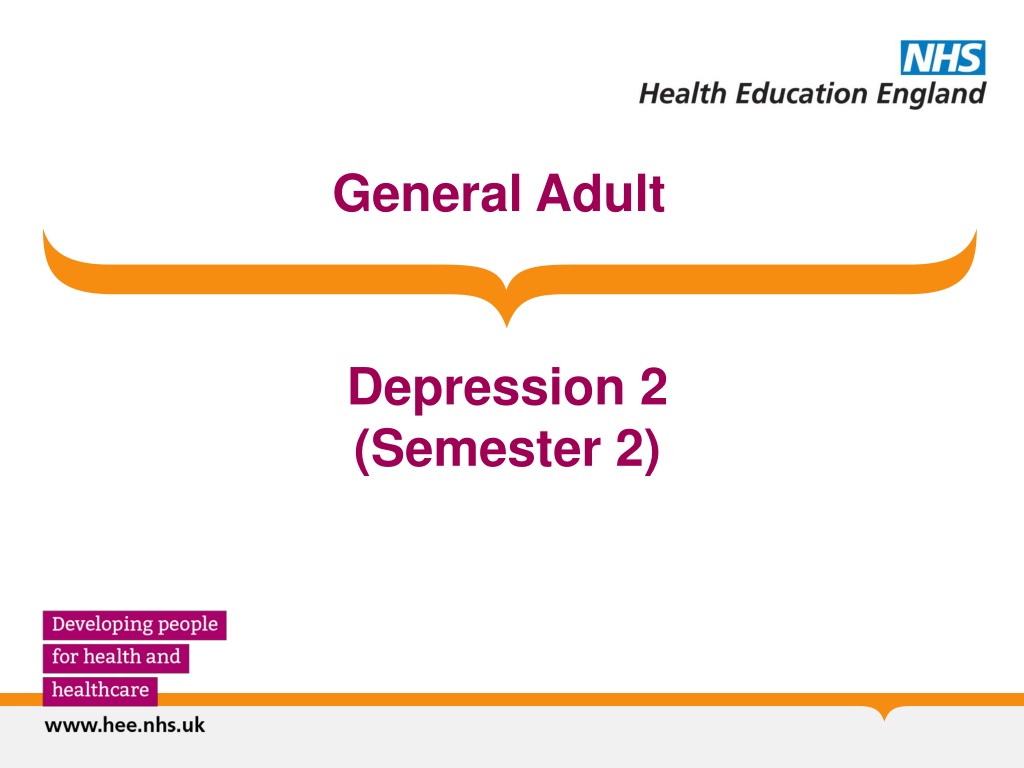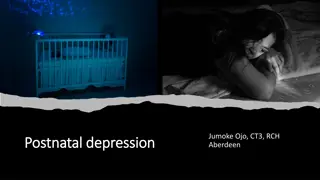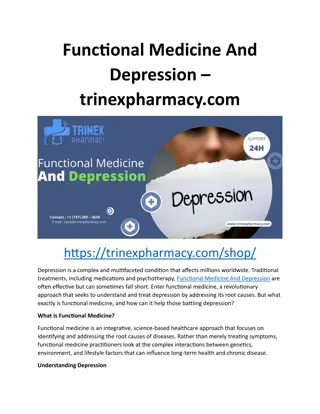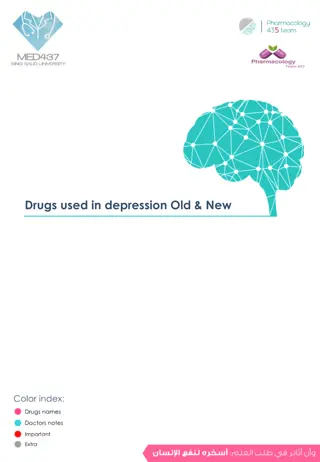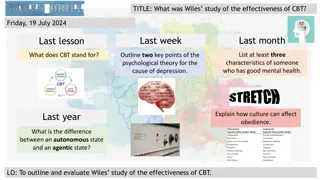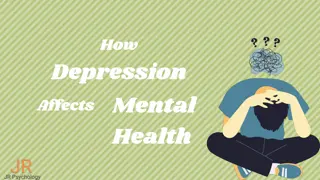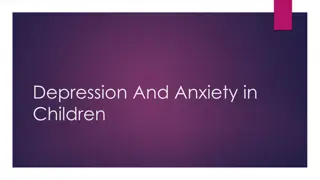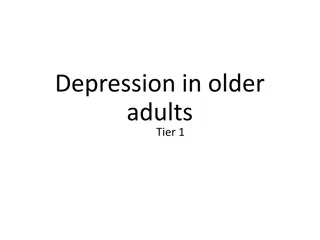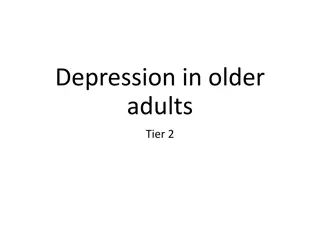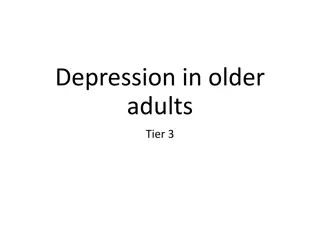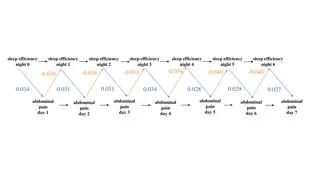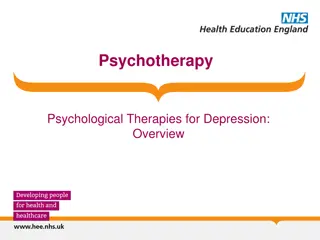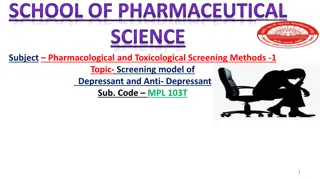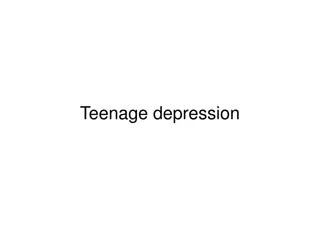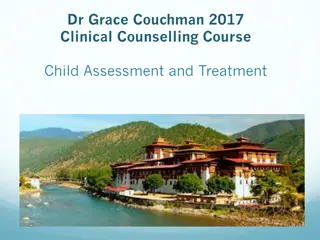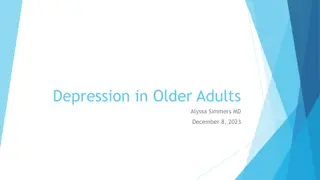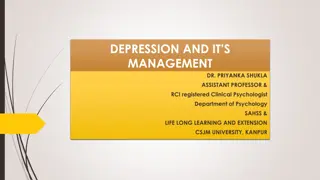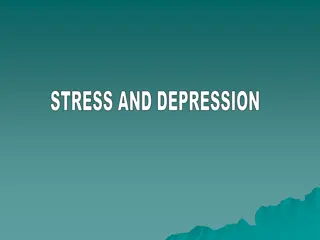Clinical Features of Depression: Understanding Symptoms
The various clinical features of depression, including mood disturbances, cognitive symptoms, goal-directed behavior changes, psychomotor alterations, and biological manifestations. Recognizing these symptoms is crucial for accurate diagnosis and management of depression.
Download Presentation

Please find below an Image/Link to download the presentation.
The content on the website is provided AS IS for your information and personal use only. It may not be sold, licensed, or shared on other websites without obtaining consent from the author.If you encounter any issues during the download, it is possible that the publisher has removed the file from their server.
You are allowed to download the files provided on this website for personal or commercial use, subject to the condition that they are used lawfully. All files are the property of their respective owners.
The content on the website is provided AS IS for your information and personal use only. It may not be sold, licensed, or shared on other websites without obtaining consent from the author.
E N D
Presentation Transcript
General Adult Depression 2 (Semester 2)
Depression - 2 Aims and Objectives To develop an understanding of the psychopathology and diagnosis in Depression. To develop an understanding of possible complications of antidepressant medications
Depression - 2 Expert Led Session Depression Pathophysiology and Diagnosis
Contents Clinical features of depression Assessing psychopathology Rating scales for depression Classification in ICD10 and DSM IV Differential diagnoses References & Further Reading
Clinical features - mood Mood of misery persistent Mood does not get better in circumstances where ordinary feelings of sadness would be alleviated. Often experienced as different from ordinary sadness. Diurnal variation usually worse in the morning, improving a little as the day wears on.
Clinical features- depressive cognitions Negative cognitions Worthlessness Pessimism Guilt Hopelessness Helplessness Can progress to thoughts of suicide
Clinical features goal-directed behaviour Anhedonia - lack of interest and enjoyment [Roots: Latin- An=not; hedon = pleasure] Social withdrawal Lethargy, reduced energy, everything is an effort. Poor motivation
Clinical features psychomotor changes Psychomotor retardation slow speech, actions, thoughts, delayed responses Negativism Blunting of affect Psychomotor agitation Restlessness, can t relax, can t sit for long Echolalia , echopraxia Irritability
Clinical features- biological symptoms Sleep disturbance early morning waking with depressive thinking is usually characteristic; also delay in falling asleep and waking during the night. Diurnal variation of mood Loss of appetite + weight Constipation Loss of libido Amenorrhoea Somatic complaints often about pre-existing symptoms.
Clinical features - other Depersonalisation Feel empty, blunt, rigid Severe Entfremdungs depression (depersonalised depression) Obsessional symptoms Panic attacks Dissociative symptoms (fugue, loss of function of a limb) Memory problems impairments in the retrieval and recognition of recently learned material particularly prominent [If severe, it may resemble dementia: depressive pseudodementia]
Psychotic depression Mood congruent delusions delusions have the same theme as the non-delusional thinking, on depressive themes worthlessness, guilt, ill-health, poverty (rare). Persecutory delusions usually the patient believes that the supposed persecution is brought upon by himself/herself; he/she is ultimately to blame indicates worse prognosis. Cotard s syndrome nihilistic delusion (more common in older adults)
Clinical variants of depression Agitated depression with agitation as a prominent feature Retarded depression with prominent psychomotor retardation Depressive stupor / catatonia motionless and mute patient Atypical depression variably depressed mood with mood reactivity to positive events; overeating and oversleeping; extreme fatigue and heaviness in the limbs; pronounced anxiety
Pointers for assessment Severity Duration Social network Views of self, world and future Suicidal thoughts Past history Factors affecting symptoms Biological features
ICD-10 criteria [F32, F33] Key Symptoms (MUST have at least 2) A. Persistent low mood B. Loss of interest or pleasure C. Fatigue or low energy 1. Disturbed sleep 2. Poor conc. Or indecisiveness 3. Low self confidence 4. Poor or increased appetite 5. Suicidal thoughts or acts 6. Agitation or slowing of movement 7. Guilt or self blame 4 symptoms = mild 5-6 symptoms = moderate 7+ symptoms= severe (+/- psychotic symptoms) If any of the above then ask about: Severity
Classification of depressive disorders ICD-10 Depressive episode DSM IV Major Depressive episode Same Mild, moderate, severe, severe with psychotic symptoms Other depressive episodes Atypical depression - Recurrent depressive disorder Major depressive disorder- recurrent - Currently mild, moderate, severe, Severe with / with out psychotic symptoms, In remission Persistent mood disorders Dysthymic disorder Cyclothymia Dysthymia Other mood disorders Depressive disorders, NOS Recurrent brief depression Recurrent brief depression [ Shorter Oxford Textbook of Psychiatry, Ed 5th ]
Major Rating Scales Scale Hamilton Scale for Depression (HAM-D) Clinician-rated; 17 item, derived from Salient features clinical interview, refers to previous 1-2 weeks, for rating severity Observer-rated, 10 item, sensitive to response to treatment, for measuring change in depressed patient. Self-reported, 21 item, lacks discriminatory power among those with very severe depression Self-rating, 20 item; >=50 indicates depression, global index of intensity of patient s depressive symptoms Montgomery-Asberg Depression Rating Scale (MADRS) Beck Depression Inventory (BDI) Zung Depression Scale [ Seminars in general adult psychiatry, Synopsis of Psychiatry ]
Differential diagnoses Normal sadness Adjustment disorder Anxiety disorders Schizophrenia esp simple schizophrenia Schizoaffective disorder Organic brain syndromes
References & Further Reading Gelder M, Harrison P, Cowen P (2006) Shorter Oxford Textbook of Psychiatry (Ed 5th) Oxford University Press. Stein G, Wilkinson G (Ed)(2007) Seminars in General Adult Psychiatry (Ed 2nd) Gaskell. Sadock BJ, Sadock VA (2007) Kaplan & Sadock s Synopsis of Psychiatry (Ed 10th) Lippincott, Williams & Wilkins. WORLD HEALTH ORGANIZATION. (1992). The ICD- 10 classification of mental and behavioural disorders: clinical descriptions and diagnostic guidelines. Geneva, World Health Organization.
Depression - 2 MCQ 1 1. Glucocorticoid receptor hypothesis is associated with which of the following (choose one answer): A. Depression B. Generalised anxiety disorder C. Dementia D. Mania E. Schizophrenia
Depression - 2 MCQ 1 The correct answer is: A - Depression Explanation: Hyperactivity of the hypothalamus pituitary adrenal (HPA) axis and increased levels of glucocorticoid hormones in patients with depression have mostly been linked to impaired feedback regulation of the HPA axis, possibly caused by altered function of the receptor for glucocorticoid hormones, the glucocorticoid receptor (GR). Antidepressants, in turn, ameliorate many of the neurobiological disturbances in depression, including HPA axis hyperactivity, and thereby alleviate depressive symptoms.
Depression - 2 MCQ 2 2. What is the approximate male : female ratio of completed suicide in England, Scotland and Wales? A. 7:1 B. 3:1 C. 5:1 D. 1:1 E. 2:1
Depression - 2 MCQ 2 The correct answer is: B - 3:1
Depression - 2 MCQ 3 3. Which of the following statements about unipolar depression is TRUE? A. Unipolar depression is three times more likely in females than in males. B. Relatives of patients with unipolar depression do not have increased rates of bipolar disorder or schizoaffective disorder. C. In twin studies, concordance rate for unipolar disorder but not bipolar disorder is higher in monozygotic than dizygotic twins. D. The familial segregation of mood disorders fits a simple Mendelian pattern. E. There is no evidence to suggest that depressive disorder in later life is associated with parental separation, especially divorce.
Depression - 2 MCQ 3 The Correct Answer is A. Unipolar depression is three times more likely in females than in males
Depression - 2 MCQ 4 4. Which of the following abnormalities in monoamine neurotransmission is NOT found in depression? A. Decreased plasma tryptophan B. Increased brain 5-HT reuptake sites C. Increased D2 receptor binding D. Clinical relapse after tryptophan depletion E. Decreased brain 5-HT1A receptor binding
Depression - 2 MCQ 4A The correct answer is: B. Brain 5 HT reuptake sites are decreased in depression
Depression - 2 MCQ 5 5. Which of the following antidepressants is associated with increased risk of cardiovascular defects in foetus, when used in the 1st trimester? A. Duloxetine B. Sertraline C. Mirtazapine D. Venlafaxine E. Paroxetine
Depression - 2 MCQ 5 5. The correct answer is: E - Paroxetine Explanation: The use of paroxetine during the first trimester of pregnancy was associated with major cardiac and congenital malformations in the foetus.
Depression - 2 Any Questions? Thank you.
